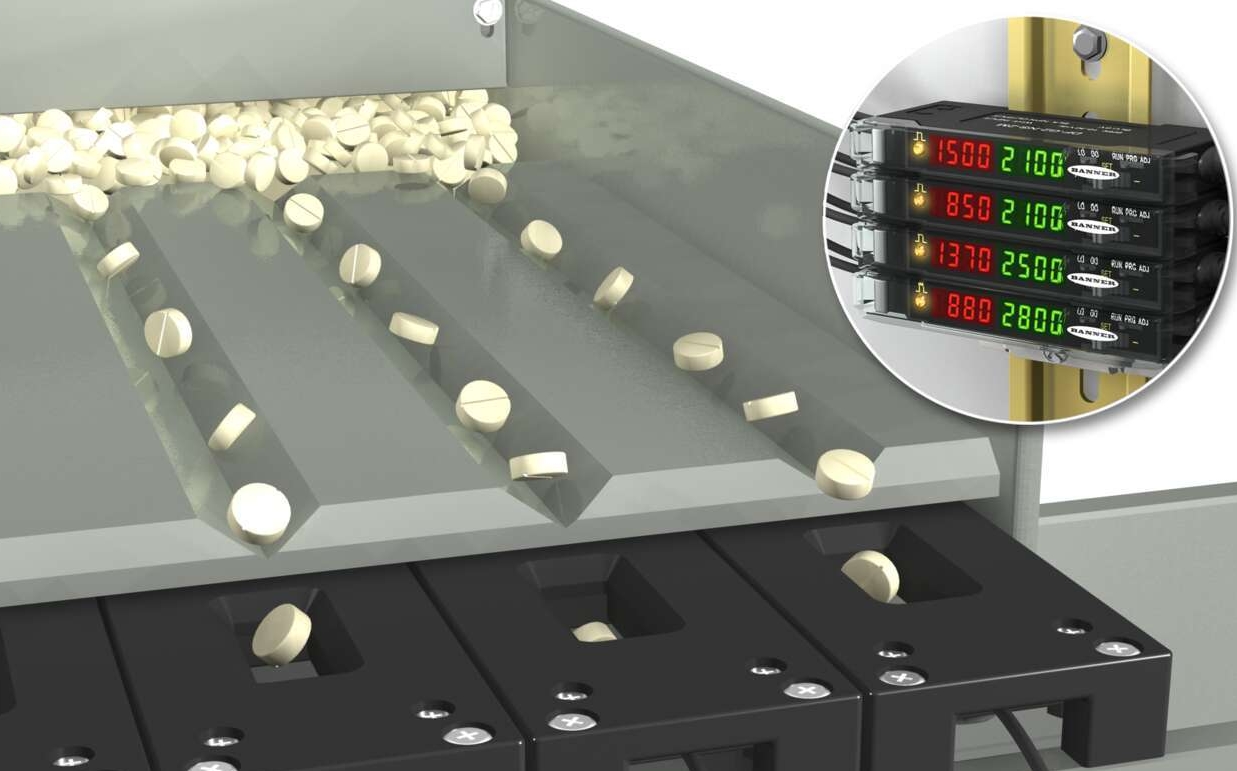How to Use Photoelectric Sensors for Tablet Counting
Image: High-speed tablet counting application.
Summary: Tablet counting and sensing technologies are used in a variety of pharmaceutical applications including bottle filling in pharmaceutical packaging, count verification in clinical trials, and even automated prescription fulfillment machines in retail pharmacies and hospitals.
Photoelectric sensors offer some important benefits for tablet detection such as outstanding counting accuracy, fast response speed, and a clean non-contact approach.
Q: What are the key parameters to consider when specifying a tablet-counting application?
Three key parameters to specify are: tablets characteristics, sensing zone, and tablet-dispensing path. The most important consideration is tablet characteristics. We look at tablet size, shape, color, reflectivity and translucency for capsules and gel caps. With the sensing zone, we’ll need to consider the size and geometry of the sensing region. Finally, tablet-dispensing path includes information related to separation distance between tablets, trajectory and free-fall speed. By considering these factors, we can help you achieve optimal sensitivity.
Q: What type of sensors can I use in tablet-counting?
Generally speaking, opposed-mode sensors (also known as through-beam) offer the most reliable sensing approach because these sensors are not affected by tablet color or reflectivity. However, you may consider other sensing options, based on the requirements of your application. Fiber optic arrays allow us to customize the coverage and sensitivity over the sensing area. Microprocessor technologies can also be incorporated to enhance sensitivity and output capabilities.
Q: What is the smallest size pill a photoelectric sensor can detect?
Based on our experience and understanding of this type of application, the smallest tablet manufactured in the pharmaceutical industry is approximately 2 mm. With the proper sensing mode and a high-resolution fiber optic array, Banner’s photoelectric sensors can reliably and repeatedly detect 2 mm diameter tablets or smaller. However, keep in mind that as the coverage of the sensing area increases, there is a tradeoff with resolution.
Q: How do I manage dust build-up from uncoated tablets?
The dust and powder from uncoated tablets collecting on a sensor lens can degrade your signal and diminish the accuracy of the application. Schedule routine cleaning and maintenance to ensure the sensing area is clear of any dust or debris. Newer sensors have active optical monitoring features to track the optical level. These features direct the sensor to compensate gain level in order to prolong operation, or they output an alarm signal for maintenance, before the sensor becomes inaccurate.
Q: Could I use a vision sensor to count tablets?
Currently, photoelectric sensing is considered the most cost-effective, practical method for non-contact, high-speed tablet sensing and count verification applications. Emerging technologies such as vision and line scanners can provide detailed information about tablet count operations, such as incomplete tablets or incorrect tablet color. Currently, the cost of such vision systems is relatively high for the extra features you get.
Q: What if two tablets come through the hopper at once. Will the through-beam be able to sense both tablets?
There are many variables involved in a free-falling tablet, including random orientation, that can affect an accurate count. Photoelectric sensors typically cannot accurately tell if more than one tablet goes through the sensing zone at a given time. Therefore, it is very important for you to make sure that the machine singulates individual tablets before they enter the sensing region. Indexing wheels, vibratory platforms, and mechanical gates are typically used to individualize tablets in dispensing machines.
Q: I can't install through-beams on my machine. Are there any other options?
We strongly recommend the use of opposed-mode (also known as through-beam) sensors. However, if space constraints and wiring path limitations do not allow the use of opposed mode, you might potentially try retro-reflective sensors as an option for those applications, especially when tablet color and reflectivity are not a concern. Contact your Banner representative to discuss some solutions.
Q: What kinds of outputs are available on photoelectric sensors?
There are two output types commonly used in tablet-counting applications. The first is a dedicated output to verify tablet count. The second is an alarm output to indicate anomalies in the process such as a blocked die or a low optical signal. In some instances a third output type, a health alarm output, can be used to monitor the operating condition of the sensor. Banner can incorporate any or all of these outputs in the sensor of your choice.
For More Information
For more information, contact one of our experts or sign up below to receive future updates.
Featured Products
Related Articles

Lean Manufacturing: 4 Lighting Solutions for Pharma Industry
This article describes several ways lighting can help increase efficiency and reduce waste while ensuring product quality & FDA compliance in the pharmaceutical industry.

How to Use Photoelectric Sensors for Tablet Counting
Photoelectric sensors offer many important benefits for tablet counting such as high accuracy, fast response speed, and a clean non-contact approach.

















.psd/jcr:content/renditions/cq5dam.thumbnail.319.319.png)






